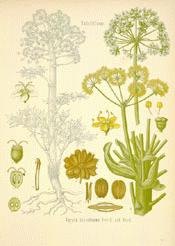
Botanical.com Home Page

|
Asafetida
(Ferula assa-foetida)
Click on graphic for larger image
|
Asafetida
Botanical: Ferula foetida (REGEL.)
Family: N.O. Umbelliferae
---Synonyms---Food of the Gods. Devil's Dung.
---Part Used---An oleogum-resin obtained by incision of root.
---Habitat---Afghanistan and Eastern Persia.
---Description---A coarse umbelliferous plant growing up to 7 feet high, large fleshy root covered with bristly fibres, has been for some time successfully cultivated in Edinburgh Botanical Gardens; stem 6 to 10 feet, numerous stem leaves with wide sheathing petioles; flowers pale greeny yellow, fruit oval, flat thin, foliaceous, reddish brown with pronounced vittae, it has a milky juice and a strong foetid odour; was first found in the sandy desert of Aral in 1844, but has been known since the twelfth century. Several species of Ferula yield Asafetida. The bulk of the drug comes from the official plant, which is indigenous to Afghanistan and grows from two to four thousand feet above sealevel. These high plains are arid in winter but are thickly covered in summer with a luxuriant growth of these plants. The great cabbage-like folded heads are eaten raw by the natives. June is the month the juice is collected from plants about four years old. The roots of plants which have not flowered are exposed and slashed, then shaded from the sun for five or six weeks and left for the gummy oleoresin to leak out and harden. It is then scraped off in reddish lumps and put into leather bags and sent to Herat, where it is adulterated before being placed on the market. The fruit is sent to India for medicinal use. A very fine variety of Asafetida is obtained from the leaf bud in the centre of the root, but this does not come into European commerce, and is only used in India, where it is known in the Bazaars as Kandaharre Hing. It appears in reddish-yellow flakes and when squeezed gives out an oil.
---Constituents---Its chief constituent is about 62 per cent of resin, 25 per cent. of gum and 7 per cent oil. The drug also contains free ferulic acid, water, and small quantities of various impurities.
---Medicinal Action and Uses---The odour of Asafetida is stronger and more tenacious than that of the onion, the taste is bitter and acrid; the odour of the gum resin depends on the volatile oil. It is much used in India and Persia in spite of its offensive odour as a condiment and is thought to exercise a stimulant action on the brain. It is a local stimulant to the mucous membrane, especially to the alimentary tract, and therefore is a remedy of great value as a carminative in flatulent colic and a useful addition to laxative medicine. There is evidence that the volatile oil is eliminated through the lungs, therefore it is excellent for asthma bronchitis, whooping-cough, etc. Owing to its vile taste it is usually taken in pill form, but is often given to infants per rectum in the form of an emulsion. The powdered gum resin is not advocated as a medicine, the volatile oil being quickly dissipated.
---Dosages and Preparations---Emulsion, Asafetida 4 parts, water 100 parts. Tincture, 1/2 to 1 fluid drachm. In pills, 3 grains of the oleogum-resin to a pill
---Adulterants---Asafetida is admittedly the most adulterated drug on the market. Besides being largely admixed with inferior qualities of Asafetida, it has often red clay, sand, stones and gypsum added to it to increase the weight.
---Other Species---The Thibetan Asafetida (Narthex Asafetida) is closely allied to the Ferulas. The umbels have no involucre, the limb of the calyx is suppressed, the stylopods depressed and cup-shaped, styles recurved, fruit compressed at back, dilated at margin. This variety produces some of the Asafetida used in commerce.
Scorodosma foetida, another gigantic umbelliferous plant found on the sandy steppes of the Caspian, also supplies the market. The Persian Sagapenum, or Serapinum, a species of Ferula which was formerly imported from Bombay, is in appearance very similar to Asafetida, but does not go pink when freshly fractured, and in smell is less disagreeable than Asafetida. This species is an ingredient of Confection Rutea, British Pharmacopceia Codex.
[Top]
Common Name Index
A MODERN HERBAL Home Page
Bear in mind "A Modern Herbal" was written with the conventional wisdom of the early 1900's. This should be taken into account as some of the information may now be considered inaccurate, or not in accordance with modern medicine.
© Copyright Protected 1995-2024 Botanical.com
|

